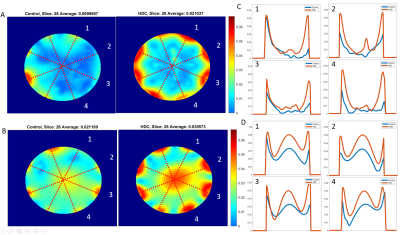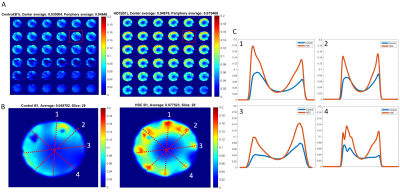Soo Han Soon1,2, Matt Waks1, Xiao-Hong Zhu1, Hannes M. Wiesner1, Navid P. Gandji3, Qing X. Yang3, Michael T. Lanagan4, and Wei Chen1
1CMRR, Department of Radiology, University of Minnesota, Minneapolis, MN, United States, 2Biomedical Engineering, University of Minnesota, Minneapolis, MN, United States, 3CNMRR, Department of Neurosurgery, Penn State University, Hershey, PA, United States, 4Department of Engineering, Penn State University, Hershey, PA, United States
1CMRR, Department of Radiology, University of Minnesota, Minneapolis, MN, United States, 2Biomedical Engineering, University of Minnesota, Minneapolis, MN, United States, 3CNMRR, Department of Neurosurgery, Penn State University, Hershey, PA, United States, 4Department of Engineering, Penn State University, Hershey, PA, United States
The design of the human head 1H RF coil based on the integrated
HDC-MTL transceiver array approach shows promise for
significantly improving the B1 efficiency and imaging sensitivity at
7T.

Fig. 3. Estimated B1+ maps of Slice 28 (marked with red boxes in Fig. 2A, 2B) in CP mode (A) and B1-shimmed mode (B). The averaged B1+ fields of all voxels in Slice 28 with the HDC-MTL transceiver array (right panels) were 2.1 times and 1.4 times higher than those with the control array (left panels). 1D profiles of selected voxels (red lines in 3A and 3B) of Slice 28 in CP mode (C) and in B1-shimmed mode (D) showed significant B1+ improvement and enhanced penetration depth after B1 shimming.

Fig. 4. Estimated relative B1- maps of 36 imaging slices covering > 10 cm in the middle of the head-shaped phantom (A); and Slice 28 (marked with red boxes in Fig. 4A) B1- map (B) with the HDC-MTL transceiver array and the control array in the B1-shimmed mode. The 1D profiles of selected voxels (red lines in 4B) showed significant improvement of the B1- field with the HDC-MTL transceiver array, especially in the periphery areas.
